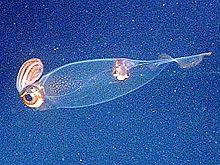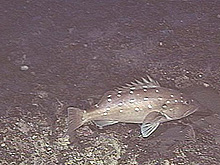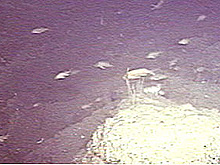
A transparent squid that hovered near the Johnson-Sea-Link II submersible at the Sandy Tongue dive site today. We did not attempt to collect this cephalopod, because it was too delicate for the sub’s suction sampling mechanism. Click image for larger view.
Groupers and Seabasses: Where Do They Live?
August 26, 2004
Zeb Schobernd
Graduate Student
Grice Marine Biological Laboratory
College of Charleston
![]() A
lantern shark swims above the sandy bottom at the Sandy Tongue dive site. (mp4, 2.8 MB)
A
lantern shark swims above the sandy bottom at the Sandy Tongue dive site. (mp4, 2.8 MB)
![]() A
huge sea anemone retrieved during the submersible dive. (mp4, 3 MB)
A
huge sea anemone retrieved during the submersible dive. (mp4, 3 MB)
![]() A
red gerion crab running along the sandy bottom. (mp4, 3.1 MB)
A
red gerion crab running along the sandy bottom. (mp4, 3.1 MB)
![]() A
bathyscaphoid squid swimming. (mp4, 3.1 MB)
A
bathyscaphoid squid swimming. (mp4, 3.1 MB)
![]() A
Venus flytrap sea anemone. (mp4, 3.4 MB)
A
Venus flytrap sea anemone. (mp4, 3.4 MB)
![]() A
frilled shark swims above the sea floor. (mp4, 3.2 MB)
A
frilled shark swims above the sea floor. (mp4, 3.2 MB)
![]() Shaefer's anglerfish brought up by the Johnson-Sea-Link II. (mp4, 5 MB)
Shaefer's anglerfish brought up by the Johnson-Sea-Link II. (mp4, 5 MB)
Today, we dove to almost 900 m in the research submersible Johnson-Sea-Link II. It was one of the deepest voyages of the Estuary to the Abyss exploration. As it turned out, it was also too deep for serranids. I’m interested in reef fish ecology and population dynamics, and my thesis project involves analyzing trends in populations of the serranid species (groupers and bass) found in the South Atlantic Bight. While it was possible to see some serranid representatives during our dive, the prospects were a bit unlikely. In this region, members of this family have been reported this deep, but most literature puts their range at 600 to 650 m.
When the submersible arrived at the bottom, we found habitat similar to a desert, with rolling sand dunes in all directions. This was an entirely different habitat from the rocky reefs that other scientists on this expedition have been exploring. While we did not see any serranids, the chance to dive has me filled with the anticipation of discovery -- and it gives me the opportunity to share a little about these organisms, which are the focus of my graduate research.

Snowy grouper are solitary predators, living on rocky reefs on the ocean floor. Click image for larger view.
Serranids live just about everywhere. From shallow water live bottom habitat to upper continental slope outcrops, the family Serranidae is one of the most diverse and well-represented families on rocky reefs in the South Atlantic Bight. While quite a bit is known about the groupers and seabasses in shallower habitats, relatively little is known about the serranids found 500 m and deeper.
The groupers
The largest members of this family are the groupers, and the most prevalent grouper at the depths we are exploring is the snowy grouper (Epinephelus niveatus). Snowy groupers are an important commercial fish in the South Atlantic, making up a substantial portion of grouper landings every year. Another deep-water representative of the family is the Warsaw grouper (Epinephelus nigritus), which can live longer than 40 years. While these fish are sometimes caught commercially or recreationally, there has been a steep decline in their numbers, and they are now too rare for us to assess the population with accuracy. Perhaps the most intriguing grouper found at these depths is the mysterious misty grouper (Epinephelus mystacinus). This fish is rarely seen, and we have virtually no information on its growth and reproductive characteristics.
All these fish are bottom feeders, eating benthic invertebrates, such as crabs, as well as other small fish and squid. We know little about some of these fishes, but hopefully by seeing them in their natural habitat, we can learn more about these interesting, but little-understood creatures.

A school of yellowfin bass. These small serranids pick plankton out of the water column near the reef where they live. Click image for larger view.
Streamer basses
Smaller representatives of this family, found far below the ocean’s surface, are the deep-water anthiines. Collectively known as streamer basses, these small- to medium-sized, generally red-colored fishes are typically seen on lower continental shelf or upper continental slope reefs. These fishes appear to eat demersal plankton (plankton that lives near the sea floor), picking copepods and other invertebrates out of the water just above the reef.
Evidence suggests that these species are protogynous hermaphrodites (animals that are born as females and change to males upon reaching a certain size or age). Some species, such as the red barbier (Hemanthias vivanus), display different characteristics between sexes, with males having longer filamentous dorsal rays and a bright yellow anal fin.
While there are anecdotal reports on their behavior, such as schooling, little else is known about the biology of these fishes. Observing these creatures in action will be a good first step towards understanding their behavior.
There are some difficulties associated with identifying these fishes from a submersible or by watching video. First, these fishes are closely related and have similar coloration and body form. Often, the main identifiable difference between fishes will be color patterns, which can be quite variable and difficult to recognize in low-light conditions. Also, there is some evidence that these fishes are a bit camera-shy. On previous submersible dives, yellowfin bass (Anthias nicholsi), have avoided the sub and its bright lights. The red barbier has also been known to dart into holes when approached.
Despite these challenges, we can discover much by viewing these fishes in their habitat. Conservation begins with education, and a great deal can be learned about these mysterious fishes on this voyage of exploration.
Sign up for the Ocean Explorer E-mail Update List.

























